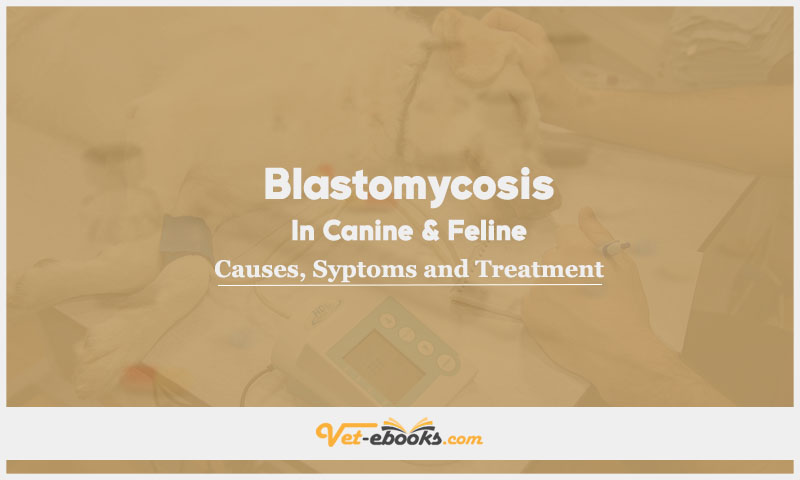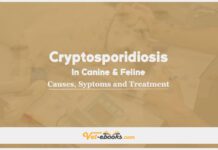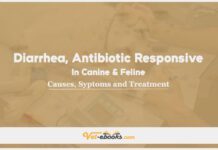Blastomycosis In Canine and Feline: Causes, Symptoms and Treatment

Contents
hide
Overview
A systemic fungal infection caused by the dimorphic soil microorganism Blastomyces dermatitidis.
Causes of Blastomycosis In Canine and Feline
- Infection caused by mycotic dimorphic soil microorganism Blastomyces dermatitidis.
- It relies on environmental and soil conditions conducive to the development of Blastomyces.
- The organism thrives in sandy, acidic soil, such as the banks of rivers, streams, lakes, or swamps.
- Most affected dogs are found to reside within 400 meters of water sources.
- There is also a risk of exposure in recently excavated areas.
- There have been reports of this infection occurring in indoor-only cats.
Pathogenesis of Blastomycosis In Canine and Feline
- When a small spore (known as conidia) is released from the mycelial stage (Ajellomyces dermatitidis) of the organism found in the soil, it is inhaled and enters the terminal airway.
- At the body’s normal temperature, the spore undergoes a transformation into its yeast form, which can then potentially initiate an infection in the lungs.
- Starting from a region of mycotic pneumonia, the yeast can spread through the bloodstream to various parts of the body.
- The immune response triggers the development of a pyogranulomatous inflammation.
Symptoms (History & Physical Examination) of Blastomycosis In Canine and Feline
History
The most frequently reported concerns typically included history of exposure to damp soil near rivers, streams, or lakes and these symptoms:
- Loss of weight
- Decreased appetite
- Coughing or dyspnea
- Lameness
- Skin lesions with drainage
For Dogs:
- Certain large-breed dogs, particularly sporting breeds, weighing over 25 kg, appear to be more commonly affected, likely due to increased exposure rather than inherent susceptibility.
- Age predilection range for infection is between 2 and 4 years, with cases beyond 7 years being uncommon.
- Males show a higher susceptibility.
For Cats:
- Age predilection is from young to middle age, and it can also occur in indoor cats.
Physical Examination
Dogs:
- Approximately 50% of patients exhibit a fever reaching up to 104 °F (40 °C).
- They may present with harsh, dry lung sounds and an elevated level of respiratory effort.
- Dogs may show generalized or regional lymphadenopathy, sometimes accompanied by skin lesions or subcutaneous swellings.
- Ocular symptoms can include uveitis, sometimes with secondary glaucoma and conjunctivitis, as well as ocular exudates and corneal edema.
- Lameness is observed in around 30% of cases, often indicating bone involvement.
- Occasional findings may include testicular enlargement and prostatomegaly.
- Some dogs may exhibit a murmur and atrioventricular (AV) block, particularly in cases of endocarditis and myocarditis.
Cats:
- Cats with this condition may experience increased respiratory effort.
- They often present with granulomatous skin lesions.
- Visual impairment can also be a notable symptom in affected cats.
Diagnosis of Blastomycosis In Canine and Feline
1- From History and Physical Examination
2- Diagnostic Procedures
CBC/Biochemistry/Urinalysis:
- A complete blood count (CBC) typically shows signs of inflammation, and chronic cases may exhibit mild anemia.
- Blood chemistry analysis often reveals elevated serum globulin levels and borderline hypoalbuminemia in cases of chronic infection.
- Some dogs may experience mild hypercalcemia.
- In dogs with prostatic involvement, Blastomyces yeasts may be detected in urine, and there might be mild proteinuria.
Other Laboratory Tests:
- Urine or serum antigen testing is highly sensitive, with a sensitivity exceeding 90%. Urine testing is even more sensitive and may cross-react with other fungal infections, such as histoplasmosis.
- Agar gel immunodiffusion (AGID) is not very sensitive in the early stages of the disease but is highly specific for identifying infection.
Imaging (Radiographs):
- In lung imaging, radiographs may reveal a generalized interstitial to nodular infiltrate, which might not have a uniform distribution.
- Tracheobronchial lymphadenopathy can also be observed.
- The radiographic changes might resemble those seen in metastatic neoplasia.
- In some cases, pleural effusion has been reported in dogs.
- Focal bone lesions can occur, displaying lytic and proliferative characteristics, potentially leading to confusion with osteosarcoma.
Diagnostic Procedures:
- Cytology of lymph node aspirates, lung samples, lytic bone aspirates, tracheal wash fluid, or impression smears of skin lesions is considered the most effective method for diagnosis.
- Histopathological examination of bone biopsies or enucleated eyes can provide valuable diagnostic information.
- Organisms are typically abundant in tissues but may be scarce in tracheal washes if there is no productive cough.
Pathologic Findings:
- Lesions typically exhibit a pyogranulomatous pattern with budding yeast cells ranging from 5 to 20 μm in diameter. These yeast cells possess a thick, refractile, double-contoured cell wall. In some cases, lesions may appear very fibrous, with only a few organisms present.
- Special fungal stains are used to aid in the detection of the organism.
3- Differential Diagnosis
- Respiratory symptoms can be associated with various underlying conditions, and a broad range of potential causes should be considered, including:
- Cardiovascular issues, such as pulmonary edema, an enlarged heart (especially the left atrium), pleural effusion, and pulmonary emboli.
- Allergic conditions, including bronchial asthma, chronic bronchitis, eosinophilic pneumonia, or granulomatosis, and pulmonary infiltrate with eosinophilia.
- Traumatic factors, like foreign body inhalation, exposure to irritating gases, or tracheal collapse.
- Neoplastic conditions, not only within the respiratory tract but also involving associated structures like ribs, lymph nodes, and muscles.
- Inflammatory causes, such as pharyngitis, tonsillitis, kennel cough resulting from agents like Bordetella bronchiseptica, parainfluenza virus, infectious laryngotracheitis virus, and mycoplasma, bacterial bronchopneumonia, chronic pulmonary fibrosis, pulmonary abscess or granuloma, and chronic obstructive pulmonary disease.
- Parasitic infections, including Oslerus (Filaroides) osleri, Crenosoma vulpis, Capillaria aerophila, Filaroides milksi, Paragonimus kellicotti, and Dirofilaria immitis, which causes heartworm disease.
- Lymph node enlargement, which may resemble lymphosarcoma but can be differentiated through cytologic examination of lymph node aspirate.
- The presence of a combination of fever and respiratory symptoms along with eye, bone, or skin involvement in a young dog may suggest the diagnosis.
Treatment of Blastomycosis In Canine and Feline
General
- It should be emphasized that infected dogs do not pose a contagion risk to other animals or people.
- Severely dyspneic dogs extended oxygen support, and approximately 25% of them experience a worsening of their respiratory condition during the initial days of treatment, which is attributed to an inflammatory response.
- Patients experiencing respiratory difficulties should have restricted physical activity.
- It’s important to convey that treatment is both costly and requires a lengthy duration.
- If medical treatment proves ineffective, the removal of an abscessed lung lobe may be necessary.
- Blind eyes should be surgically removed (enucleated) to eliminate potential sites of lingering infection.
Medications:
Itraconazole:
- For dogs, the initial dosage is 5 mg/kg administered orally every 12 hours, ideally with a meal high in fat (e.g., canned dog food) for the first three days. Afterward, the dosage can be reduced to 5 mg/kg once daily.
- In cats, the recommended dosage is 5 mg/kg orally every 12 hours. This involves opening 100 mg capsules containing pellets and mixing them with palatable food.
- Avoid using antacid medications as itraconazole is best absorbed in an acidic environment.
- Treatment should continue for a minimum of 90 days, or for one month after all signs of the disease have resolved, whichever is longer.
- The use of compounded itraconazole is not recommended due to unreliable absorption.
Fluconazole:
- In dogs, the suggested dosage is 5 mg/kg administered orally every 12 hours.
- For cats, the dosage ranges from 5 to 10 mg/kg orally every 12 to 24 hours, or 50 mg per cat.
- Fluconazole is cost-effective but may require a longer treatment duration.
Amphotericin B:
- Amphotericin B is reserved for dogs with neurological symptoms or those facing life-threatening disease.
- The recommended dosage is 0.5 to 1.0 mg/kg administered intravenously every 48 hours. For dogs with renal dysfunction, a lipid complex of amphotericin B is advisable.
Some Notes:
- The most commonly observed sign of Itraconazole and Fluconazole toxicity is a loss of appetite, which is linked to potential liver-related issues.
- It is recommended to regularly monitor serum alanine aminotransferase (ALT) activity, with monthly checks or when anorexia is detected.
- In cases where patients experience anorexia and show moderate ALT activity elevation, temporarily discontinuing the medication is advised.
- Once the appetite improves, treatment can be resumed at half the previous dose.
- In some dogs, ulcerative dermatitis may occur as a result of vasculitis, and the severity is dose-dependent.
- Inform the owner about the financial costs associated with treatment, which typically spans a minimum of 60 to 90 days.
- The duration of treatment should be determined based on the resolution of clinical symptoms and follow-up chest radiographs.
- It’s important to note that significant and permanent lung changes can occur even after the infection has cleared, making it challenging to confirm the presence of persistent active disease.
- If, after 60 days of treatment, active lung disease is still evident, treatment should be extended for an additional 30 days.
- If the lungs appear normal at this point, treatment can be discontinued, and repeat radiographs should be obtained after 30 days.
- By the 90th day of treatment, if the condition remains unchanged from day 60, it is likely due to residual effects.
- The presence of fibrosis on radiographs indicates inactive disease. If the condition has improved compared to day 60, continue treatment for an additional 30 days. If lesions have worsened significantly, consider switching to amphotericin B and then obtain another radiograph.
- At the 120-day mark of treatment, obtain another radiograph and continue treatment as long as there is lung improvement. If there is no further improvement and no signs of active disease, the lesions are likely scarring.
- The prognosis is guarded, with approximately 25% of dogs succumbing during the first week of treatment. Early diagnosis improves the chances of survival.
- Prognosis is influenced by the severity of lung involvement and the extent of invasion into the central nervous system.
- Recurrence is seen in about 20% of dogs, typically within 3–6 months after treatment completion, but it may occur up to 15 months afterward. A second course of itraconazole treatment is usually effective, as drug resistance to itraconazole has not been observed.
- Owners should be informed that there is no risk of transmission from animals to humans, except through bite wounds. Additionally, they should be made aware when inoculation of organisms has occurred from dog bites.
- Caution is necessary during necropsies of infected dogs to avoid cuts, and care should be taken to prevent needle sticks when aspirating lesions.
Tip
Do You Want To Increase Your Veterinary Knowledge and Practical Skills?
You Can Now Browse and Download +3000 Books For Veterinary Professionals & Students Online.
Download Veterinary Books
















